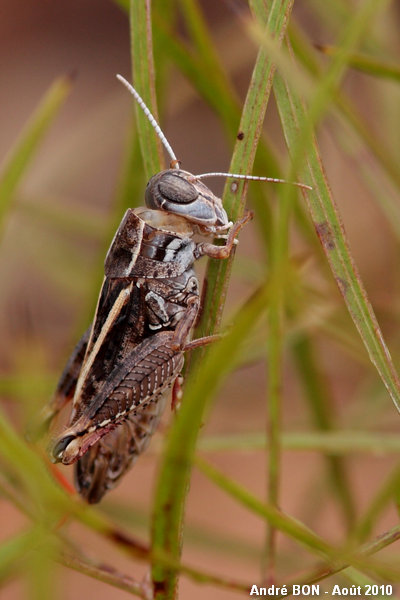
| Calliptamus wattenwylianus (Pantel, 1896) |

|
|
Scientific name: Calliptamus wattenwylianus (Pantel, 1896) Common name: French name: Caloptène occitan Order: Orthoptera Family: Acrididae Wingspan : Males: 20 to 22 mm. Like with all species of the same genus, females are much larger than males. Biotope: Garrigues, open waste lands, dunes, cultivated fields. Geographic area: Mediterranean coasts of southern France, Spain and North Africa, east to the Nile delta. Atlantic coasts of Morocco. Observation period : July to October. |
The locusts of the Calliptamus genus show a prosternal tubercle. This is a kind of protruding knob located on the underside between the fore legs (not very easy to see without putting the locust upside down). The eyes are a large size and appear vertically striped. The hind wings, only visible in flight, are bright pink without any black marks and sometimes not coloured. The pronotum has well marked lateral carinae. Males have large curved and pincer-like cerci. The keys used to tell species apart, for males, are based on the shape of the pallium (membrane covering penis valves and visible on the upper side of the abdomen tip), the length and the shape of the tegmina, the colour and the patches on the inner side of the femora among other features. Identification of the species is rather difficult because there are important variations inside each species depending on the habitat (plain, desert, mountain) and depending on the region. Among about fifteen species in the Calliptamus genus, we will only deal with the four ones you can see in France especially in the south. The male Calliptamus wattenwylianus has not a so protruding pallium than the Italian Locust (Calliptamus italicus) where it is long, pointed and protruding backwards (shark's dorsal fin shape). Calliptamus wattenwylianus's tegmina never extend beyond the hind knees. The tegmina are narrowed towards the apex while they have rather parallel edges on the Italian Locust (Calliptamus italicus) and on Calliptamus barbarus. They are also narrowed on Calliptamus siciliae. The tegmina reach or exceed the hind knees on the Italian Locust (Calliptamus italicus) and on Calliptamus barbarus. The pallium is rather distant from the apex of the subgenital plate on the abdomen tip of Calliptamus wattenwylianus while it is very close on Calliptamus siciliae. Some years these locusts may pullulate (especially the Italian Locust) and cause important damages to crops. |
| [To know more about the Calliptamus wattenwylianus] [Top] |

|
I have shot this picture not far from the Pic de l'Ours in the Estérel mountains. You can see the curved cerci at the tip of the abdomen. This one is a male. Though the focus is on the eyes, you can see the pallium (kind of small dark ball on the upper side of the abdomen tip). The shape of the pallium, moderately raised, rather rounded and not pointed, enables to discard the Italian Locust (Calliptamus italicus). The distance of the pallium to the tip of the abdomen enables to discard Calliptamus siciliae on which the pallium is normally very close to the tip. Unfortunately we cannot clearly see the shape of the tegmina. The tegmina just reach the hind knee. The fact that we do not see a part of the tegmen under the knee may show that it is narrowed towards the tip. So there is a high probability that this specimen is Calliptamus wattenwylianus with a small remaining doubt about Calliptamus barbarus. |